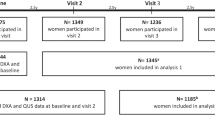Abstract
Low calcaneal ultrasound measurement (quantitative ultrasound, QUS) has been shown to predict fractures in elderly women. However, only a few studies have examined its ability to predict perimenopausal and early postmenopausal fractures. We conducted a prospective population-based cohort study to assess the capability of QUS as compared to axial BMD measurement to predict early postmenopausal fractures at that age. Four hundred and twenty-two women (mean age 59.6, range 53.7–65.3) from the Kuopio Osteoporosis Risk Factor and Prevention Study (OSTPRE) were randomly chosen to undergo a calcaneal ultrasound measurement. In all, 9.4% of these women were premenopausal at the time of measurement. Thirty-two follow-up fractures were reported during the mean follow-up of 2.6 years (SD 0.7). These were validated with patient record perusal. Broadband ultrasound attenuation (BUA), speed of sound (SOS) and stiffness index (SI) were significantly lower among women with than without fracture (P-values 0.028, 0.001 and 0.001, respectively). Mean T-score adapted from SI was −1.5 (95% CI −1.7 to −1.2) for fracture group and −1.0 (95% CI −1.1 to −0.9) for the non-fracture group. All QUS measurements predicted fractures even after adjusting for age, weight, height, previous fracture history, femoral neck BMD and use of hormone replacement therapy according to Cox regression. The adjusted hazard ratios (HR, 95% confidence interval) of a follow-up fracture for a 1 SD decrease were 1.80 (1.27–2.56), 1.72 (1.21–2.45) and 1.43 (1.01–2.03) for SOS, SI and BUA, respectively. Similarly, the adjusted HR for a 1 SD decrease of spinal BMD was 1.27 (0.85–1.94) and for that of femoral neck BMD 1.14 (0.78–1.70). In receiver operator analyses, the area under the curve (AUC) was greatest for QUS measurements: SOS (AUC=0.68), stiffness (AUC=0.67), BUA (AUC=0.62) and least for lumbar BMD (AUC=0.56), while and femoral neck BMD (AUC=0.59). The difference between AUCs was statistically significant between SI and lumbar BMD (P=0.02, Duncan’s P=0.07). We conclude that low calcaneal QUS predicts early postmenopausal fractures as well as or even better than axial BMD.


Similar content being viewed by others
References
Consensus development conference (1993) Diagnosis, prophylaxis, and treatment of osteoporosis. Am J Med 94:646–650
Kanis JA, Delmas P, Burckhardt P, Cooper C, Torgerson D (1997) Guidelines for diagnosis and management of osteoporosis: the European Foundation for Osteoporosis and Bone Disease. Osteoporos Int 7:390–406
Njeh CF, Boivin CM, Langton CM (1997) The role of ultrasound in the assessment of osteoporosis: a review. Osteoporos Int 7:7–22
Miller PD, Njeh CF, Jankowski LG, Lenchik L (2002) International Society for Clinical Densitometry Position Development Panel and Scientific Advisory Committee. What are the standards by which bone mass measurement at peripheral skeletal sites should be used in the diagnosis of osteoporosis? J Clin Densitom 5:S39–45
Porter RW, Miller CG, Grainger D, Palmer SB (1990) Prediction of hip fracture in elderly women: a prospective study. BMJ 29:638–641
Bauer DC, Gluer CC, Cauley JA, Vogt TM, Ensrud KE, Genant HK et al. (1997) Broadband ultrasound attenuation predicts fractures strongly and independently of densitometry in older women. A prospective study. Study of Osteoporotic Fractures Research Group. Arch Int Med 157:629–634
Hans D, Dargent-Molina P, Schott AM, Sebert JL, Cormier C, Kotzki PO et al. (1996) Ultrasonographic heel measurements to predict hip fracture in elderly women: the EPIDOS prospective study. Lancet 348:511–514
Stewart A, Torgerson DJ, Reid DM (1996) Prediction of fractures in perimenopausal women: a comparison of dual energy X-ray absorptiometry and broadband ultrasound attenuation. Ann Rheum Dis 55:140–142
Thompson PW, Taylor J, Oliver R, Fisher A (1998) Quantitative ultrasound (QUS) of the heel predicts wrist and osteoporosis-related fractures in women age 45–75 years. J Clin Densitom 1:219–225
Gnudi S, Ripamonti C, Malavolta N (2000) Quantitative ultrasound and bone densitometry to evaluate the risk of nonspine fractures: a prospective study. Osteoporos Int 11:518–523
Hanley JA, McNeil BJ (1983) A method of comparing the areas under receiver operating characteristic curves derived from the same cases. Radiology 1148:839–843
Pluijm SM, Graafmans WC, Bouter LM, Lips P (1999) Ultrasound measurements for the prediction of osteoporotic fractures in elderly people. Osteoporos Int 9:550–556
Bouxsein ML, Radloff SE (1997) Quantitative ultrasound of the calcaneus reflects the mechanical properties of calcaneal trabecular bone. J Bone Miner Res 12:839–846
Honkanen R, Kroger H, Tuppurainen M, Alhava E, Saarikoski S (1995) Fractures and low axial bone density in perimenopausal women. J Clin Epidemiol 48:881–888
Kroger H, Huopio J, Honkanen R, Tuppurainen M, Puntila E, Alhava A, Saarikoski S (1995) Prediction of fracture risk using axial bone mineral density in a perimenopausal population: a prospective study. J Bone Miner Res 10:302–306
Huopio J, Kroger H, Honkanen R, Saarikoski S, Alhava E (2000) Risk factors for perimenopausal fractures. A prospective study. Osteoporos Int 11:219–227
Torgerson DJ, Campbell MK, Thomas RE, Reid DM (1996) Prediction of perimenopausal fractures by bone mineral density and other risk factors. J Bone Miner Res 11:293–297
Tuppurainen M, Kroger H, Honkanen R, Puntila E, Huopio J, Saarikoski S et al. (1995) Risks of perimenopausal fractures—a prospective population-based study. Acta Obstet Gynecol Scand 74:624–628
Blake GM, Fogelman I (2001) Peripheral or central densitometry: does it matter which technique we use? J Clin Densitom 4:83–96
Cauley JA, Thompson DE, Ensrud KC, Scott JC, Black D (2000) Risk of mortality following clinical fractures. Osteoporos Int 11:556–561
Njeh CF, Hans D, Li J, Fan B, Fuerst T, He YQ, Tsuda-Futami E, Lu Y, Wu CY, Genant HK (2000) Comparison of six calcaneal quantitative ultrasound devices: precision and hip fracture discrimination. Osteoporos Int 11:1051–1062
Author information
Authors and Affiliations
Corresponding author
Rights and permissions
About this article
Cite this article
Huopio, J., Kröger, H., Honkanen, R. et al. Calcaneal ultrasound predicts early postmenopausal fractures as well as axial BMD. A prospective study of 422 women. Osteoporos Int 15, 190–195 (2004). https://doi.org/10.1007/s00198-003-1534-9
Received:
Accepted:
Published:
Issue Date:
DOI: https://doi.org/10.1007/s00198-003-1534-9




